Intensive agriculture, done secretly in forests, has a big impact on wildlife such as fishers.
Author Archives: MadelineBodin
Penn State Develops CWD Model
 Eight years ago, research done by Penn State University, the Pennsylvania Wildlife Commission, and the US Geological Survey found in a study of white-tailed deer, that 70 percent of yearling males will disperse, and the average dispersal is six to seven miles. Depending on the amount of forest on the landscape, the researcher says, those yearling males may go just a mile or as far as 30 miles.
Eight years ago, research done by Penn State University, the Pennsylvania Wildlife Commission, and the US Geological Survey found in a study of white-tailed deer, that 70 percent of yearling males will disperse, and the average dispersal is six to seven miles. Depending on the amount of forest on the landscape, the researcher says, those yearling males may go just a mile or as far as 30 miles.
Now, another team of Penn State researchers are using that dispersal data to model the spread of chronic wasting disease (CWD) in Pennsylvania.
So far, the conclusions are that in parts of the state with less forest, the Game Commission may have to consider disease-management areas that are larger. It also has implications on sampling efforts to try to get a handle on the prevalence of the disease.
Read the Penn State University press release here.
Photo: Joe Kosack/Pennsylvania Game Commission
Is a Bad Diet Killing Manatees?
 First it was the manatees in southwestern Florida. A red tide is killing them. Then manatees started dying on Florida’s east coast too, although there the cause is a mystery.
First it was the manatees in southwestern Florida. A red tide is killing them. Then manatees started dying on Florida’s east coast too, although there the cause is a mystery.
An article in the Tampa Bay Times says that the manatees’ bellies are full of algae, and since manatees usually munch on sea grass, that may be the problem. With the sea grass killed off by previous toxic algae events, perhaps the manatees are eating algae, which is not giving them the nutrition they need.
Read the Tampa Bay Times article here.
Mother Jones also covered the manatee insanity, here.
The Florida Today report includes video.
And it’s not just manatees that are dropping dead in Florida. According to Florida Today, over 100 pelicans have been found dead in Brevard County in the past two months.
“The pelicans are emaciated and have heavy parasite counts, and, to our knowledge, other bird species have not been affected,” said Dan Wolf, a Florida Fish and Wildlife Conservation Commission researcher in a commission press release.
Read the Florida Today pelican article,here.
Read the FWC press release, here.
Photo: courtesy Florida Fish and Wildlife Conservation Commission
Butterfly Heads and Tails
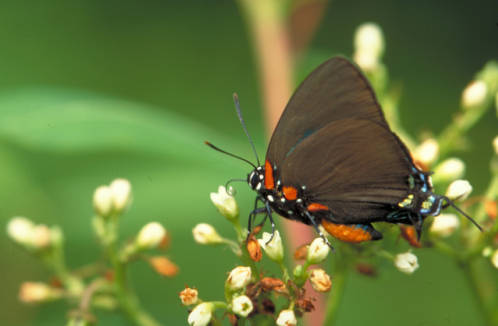 Recently published research from the Florida Museum of Natural History’s McGuire Center for Lepidoptera and Biodiversity provides experimental confirmation that the thing that looks like a second head on the back wings of some hairstreak butterflies does indeed protect the butterflies from predators, as has long been guessed.
Recently published research from the Florida Museum of Natural History’s McGuire Center for Lepidoptera and Biodiversity provides experimental confirmation that the thing that looks like a second head on the back wings of some hairstreak butterflies does indeed protect the butterflies from predators, as has long been guessed.
The surprise was what predator it provided protection from. The conventional wisdom has said that adaptive coloration protects butterflies from birds, the researcher, Andrei Sourakov, says in a University of Florida press release. But this research showed that the fake heads were very successful at deterring jumping spiders — which easily took down other butterflies without fake heads on their hind-wings.
This may not be much help in day-to-day wildlife management, but it is a cool piece of research, and with several hairstreaks endangered or threatened at the state level, you never know when you’ll be writing up a hairstreak management plan.
The University of Florida press release.
The open access Journal of Natural History paper.
Photo: Great purple hairstreak by Dr. Thomas G. Barnes/University of Kentucky, used courtesy of the US Fish and Wildlife Service
Guns, Money and Wildlife
Talk of gun control after the Newtown, Connecticut school shootings in December has lead to panic gun buying across the nation. The surge in sales has the potential to benefit wildlife. (A number of articles on the subject also mention the improving economy and the popularity of the movie The Hunger Games, which lead to interest in archery, for some of the increase.)
The federal Pittman-Robertson Act has collected an 11 percent excise tax on hunting gear (including shotguns and archery bows) since the Depression and distributed that money to the states. Along with hunting licenses, it is how most wildlife conservation on the state level is funded.
Most articles report a windfall. PressConnect.com of Binghampton, NY predicts a windfall, even though Congress will siphon off more than eight percent of the funds under the sequester legislation.
This doesn’t mean that spending the extra money will be easy. In an article in the Charleston (WV) Gazette, Curtis Taylor, wildlife chief for the West Virginia Division of Natural Resources points out the state’s need to match the federal funds, 25 cents on the dollar.
Plus, with other funding plummeting, and the panic sales not expected to last forever, states such as West Virginia must invest in things that won’t require a lot of overhead in the future. And, oh yeah, that means adding more staff is probably out of the question.
The Milwaukee Journal-Sentinel takes the time to report that the fisheries side of things won’t be getting a windfall. A separate federal law taxes fishing equipment to protect fisheries, and well, sales of fishing equipment just haven’t sky-rocketed.
The Charleston Gazette article is the most nuanced, but here is some other coverage of the gun sale windfall:
Tribune-Review (Pittsburgh region)
Milwaukee Journal-Sentinel
PressConnects.Com (Binghamption, NY)
Spokane Spokesman-Review
More on Minnesota Moose
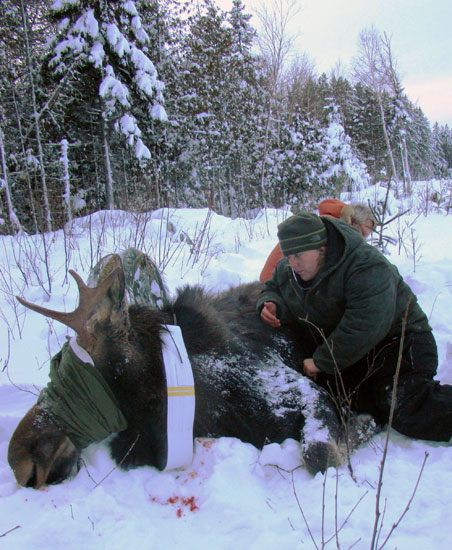 Loss of early successional habitat, more wolves, and increased exposure to brainworm — those are the early theories on why the Minnesota moose population is plummeting. And that’s a whole lot of inference from just two dead moose.
Loss of early successional habitat, more wolves, and increased exposure to brainworm — those are the early theories on why the Minnesota moose population is plummeting. And that’s a whole lot of inference from just two dead moose.
The Duluth News Tribune has an update on the moose study begun by the Minnesota Department of Natural Resources in January. The DNR tagged 111 moose and planned to follow them for five years — deploying a team to investigate whenever one of the moose died. (We covered it here.)
So far six moose have died, the article says. Four of those deaths have been pinned on capture-related mortality. The percentage is about average for moose captures, the article says.
The two other moose were killed by wolves. The article reports on another researcher in conducting a separate study who found that one of his wolf-killed moose had pneumonia.
There are many more details about the early days of the study in the article. Read the Duluth News Tribune article here.
Photo: A moose being collared, but not necessarily for this project. Courtesy of the Minnesota Department of Natural Resources
Chagas Disease in South Texas Wildlife
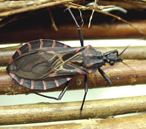 Chagas disease, spread by kissing bugs or reduviid bugs is a scourge in South America, has the potential to cause heart failure. The symptoms can be chronic and go on for years.
Chagas disease, spread by kissing bugs or reduviid bugs is a scourge in South America, has the potential to cause heart failure. The symptoms can be chronic and go on for years.
Until recently, the disease and the insects that carry it were rare even in northern Mexico, but recently, says a report on the KABB Fox News TV station in San Antonio, Texas, the number of the kissing bugs found in south Texas has increased sharply.
More to the point, the piece says, a recent survey by Texas A&M researchers found that 60 to 80 percent of the mammals trapped on public land have been found to be infected by the disease. The animals trapped include feral hogs, white-tailed deer, wood rats, rabbits and raccoons.
Watch or read the piece on the KABB website, here.
More on Chagas disease at PubMed Health, and
probably more than you want to know, unless you have it, from the Centers for Disease Control
Photo: A kissing bug of the type that carries the parasite that causes Chagas disease, courtesy of the Centers for Disease Control
Lots o’ Legislation
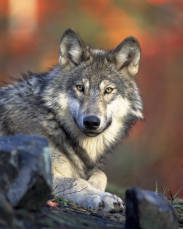 I know, you are trying to focus on science and have no interest in the political scene. And I know that lots of bills get passed, but few of them become laws. Every once in a while, it is worth mentioning the gears of law, though. In this case it is worth mentioning because both the Idaho and Utah legislatures were very busy in late February creating new laws about endangered species.
I know, you are trying to focus on science and have no interest in the political scene. And I know that lots of bills get passed, but few of them become laws. Every once in a while, it is worth mentioning the gears of law, though. In this case it is worth mentioning because both the Idaho and Utah legislatures were very busy in late February creating new laws about endangered species.
The Associated Press reported that a bill that passed the Idaho Senate “would make it against state policy for federal officials to introduce or reintroduce any threatened or endangered species in Idaho without state approval.”
But there’s not much more than that on the bill. Read it the brief piece on The Oregonian website, here.
Utah was extra busy. They’ve got three bills in the works. One House bill would, according to the Salt Lake City Tribune, “allow county assessors to reduce a property’s tax burden if its value is impacted by designation as critical habitat for threatened or endangered species.”
Another House bill, “asks the federal government to not designate any private land in San Juan County as sage grouse habitat,” says the Salt Lake City Tribune. And a Senate bill which, “endorses Iron County taking over recovery of the Utah prairie dog” from the US Fish and Wildlife Service.
The Utah legislature also put $300,000 in its budget to prevent the federal government from reintroducing the gray wolf into the state, another Salt Lake City Tribune article says. The article says that federal officials deny that any such reintroduction is planned.
Read the Salt Lake City Tribune article on the wolf payment here.
And props to Brian Maffly, the Salt Lake City Tribune reporter on both of those stories for making dull legislative news lively and easy to understand.
Photo: gray wolf by Gary Kramer, used courtesy USFWS
Monarch Pops Plummet
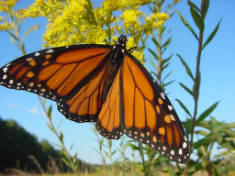 The Washington Post reports that the monarch butterfly population wintering in Mexico has shown a drop in six of the last seven years. “…There are now only one-fifteenth as many butterflies as there were in 1997,” the article says.
The Washington Post reports that the monarch butterfly population wintering in Mexico has shown a drop in six of the last seven years. “…There are now only one-fifteenth as many butterflies as there were in 1997,” the article says.
Journey North reports that this year’s population is lowest since record-keeping began.
Drought and herbicides that have killed off milkweed, which the monarchs require as host plants — particularly in the Midwest, are thought to be the main contributors to the decline. While populations have rebounded after drops, the overall trend is down, down, down.
Read the Washington Post article here.
Read an Associated Press article here.
The Journey North Facebook page is here.
Photo: Monarch butterfly by Mark Musselman, used courtesy of the US Fish and Wildlife Department.
The Word on Birds
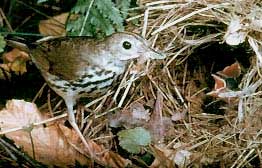 The recent issue of The Auk (subscription or fee required to read full articles) has several articles of interest to state wildlife biologists:
The recent issue of The Auk (subscription or fee required to read full articles) has several articles of interest to state wildlife biologists:
It has long been assumed that early successional forests are important habitat for young ovenbirds. A paper by Andrew Vitz, now with the Massachusetts Division of Fisheries and Wildlife, tested that hypothesis experimentally. He found that the density of understory vegetation was a factor in the birds’ survival, but that the birds could do well in smaller patches of early successional habitat, such as microhabitats within mature forests.
A paper on California spotted owls found that two is the magic number for a number of offspring. Owls that were part of a pair of nestlings had higher survival rates that onlies or triplets. The research also found that the number of young produced is a good indicator of habitat quality.
Read the spotted owl paper here.
Piping plovers hatched earlier in the season in the Great Lakes region had a higher survival rate than those born later in the season, another paper reported. Nest sites that were closer to trees also had lower survival rates. The older the plover chicks were, the more likely they were to live another day. Because the Great Lakes population of piping plovers is federally endangered (with other populations being threatened), these factors can help inform management strategies.
Read the piping plover paper here.
Photo: ovenbird, courtesy Wisconsin Division of Natural Resources
